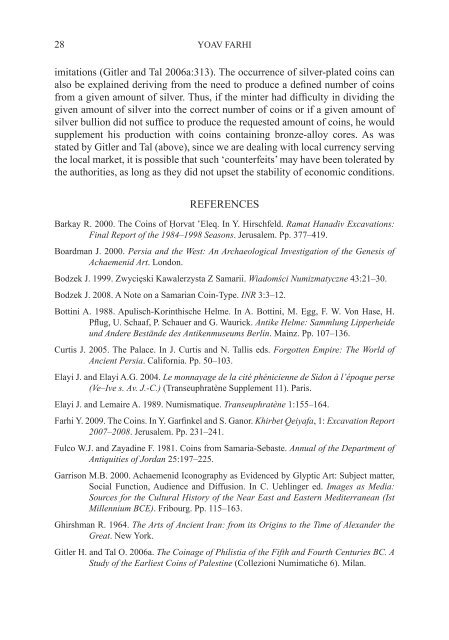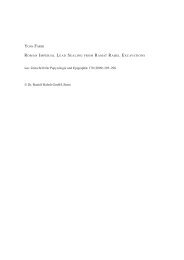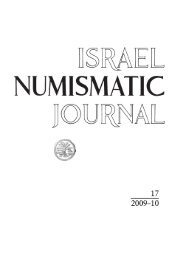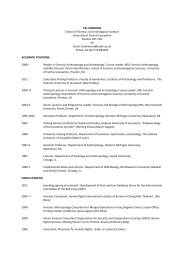Israel Numismatic Research - Institute of Archaeology
Israel Numismatic Research - Institute of Archaeology
Israel Numismatic Research - Institute of Archaeology
You also want an ePaper? Increase the reach of your titles
YUMPU automatically turns print PDFs into web optimized ePapers that Google loves.
28 YOAV FARHI<br />
imitations (Gitler and Tal 2006a:313). The occurrence <strong>of</strong> silver-plated coins can<br />
also be explained deriving from the need to produce a defined number <strong>of</strong> coins<br />
from a given amount <strong>of</strong> silver. Thus, if the minter had difficulty in dividing the<br />
given amount <strong>of</strong> silver into the correct number <strong>of</strong> coins or if a given amount <strong>of</strong><br />
silver bullion did not suffice to produce the requested amount <strong>of</strong> coins, he would<br />
supplement his production with coins containing bronze-alloy cores. As was<br />
stated by Gitler and Tal (above), since we are dealing with local currency serving<br />
the local market, it is possible that such ‘counterfeits’ may have been tolerated by<br />
the authorities, as long as they did not upset the stability <strong>of</strong> economic conditions.<br />
REFERENCES<br />
Barkay R. 2000. The Coins <strong>of</strong> Ḥorvat ‛Eleq. In Y. Hirschfeld. Ramat Hanadiv Excavations:<br />
Final Report <strong>of</strong> the 1984–1998 Seasons. Jerusalem. Pp. 377–419.<br />
Boardman J. 2000. Persia and the West: An Archaeological Investigation <strong>of</strong> the Genesis <strong>of</strong><br />
Achaemenid Art. London.<br />
Bodzek J. 1999. Zwycięski Kawalerzysta Z Samarii. Wiadomści Numizmatyczne 43:21–30.<br />
Bodzek J. 2008. A Note on a Samarian Coin-Type. INR 3:3–12.<br />
Bottini A. 1988. Apulisch-Korinthische Helme. In A. Bottini, M. Egg, F. W. Von Hase, H.<br />
Pflug, U. Schaaf, P. Schauer and G. Waurick. Antike Helme: Sammlung Lipperheide<br />
und Andere Bestände des Antikenmuseums Berlin. Mainz. Pp. 107–136.<br />
Curtis J. 2005. The Palace. In J. Curtis and N. Tallis eds. Forgotten Empire: The World <strong>of</strong><br />
Ancient Persia. California. Pp. 50–103.<br />
Elayi J. and Elayi A.G. 2004. Le monnayage de la cité phénicienne de Sidon à l’époque perse<br />
(Ve–Ive s. Av. J.-C.) (Transeuphratène Supplement 11). Paris.<br />
Elayi J. and Lemaire A. 1989. Numismatique. Transeuphratène 1:155–164.<br />
Farhi Y. 2009. The Coins. In Y. Garfinkel and S. Ganor. Khirbet Qeiyafa, 1: Excavation Report<br />
2007–2008. Jerusalem. Pp. 231–241.<br />
Fulco W.J. and Zayadine F. 1981. Coins from Samaria-Sebaste. Annual <strong>of</strong> the Department <strong>of</strong><br />
Antiquities <strong>of</strong> Jordan 25:197–225.<br />
Garrison M.B. 2000. Achaemenid Iconography as Evidenced by Glyptic Art: Subject matter,<br />
Social Function, Audience and Diffusion. In C. Uehlinger ed. Images as Media:<br />
Sources for the Cultural History <strong>of</strong> the Near East and Eastern Mediterranean (Ist<br />
Millennium BCE). Fribourg. Pp. 115–163.<br />
Ghirshman R. 1964. The Arts <strong>of</strong> Ancient Iran: from its Origins to the Time <strong>of</strong> Alexander the<br />
Great. New York.<br />
Gitler H. and Tal O. 2006a. The Coinage <strong>of</strong> Philistia <strong>of</strong> the Fifth and Fourth Centuries BC. A<br />
Study <strong>of</strong> the Earliest Coins <strong>of</strong> Palestine (Collezioni Numimatiche 6). Milan.






